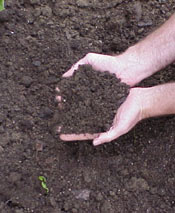 Choosing a Garden Site
Choosing a Garden Site
Most vegetables need at least six to eight hours of sun a day to produce well, and full sun is best, especially in cooler northern climates. Plants grown for their fruits, such as tomatoes, peppers, and eggplant, need the most sun; leafy vegetables like spinach and chard can tolerate some light shade during part of the day.
Before You Dig In
Wait until the soil dries out in the spring before tilling. Tilling or otherwise working wet soil will compact it, leaving it in worse shape than if you hadn't tilled at all. When tilling, don't overdo it. Two or three passes with a tiller should be plenty for an established garden. Overtilling damages soil; you want to loosen the soil, not pulverize it.
Improving Soil
The ideal garden soil is a rich loam with excellent drainage. Loamy soil contains a range of particle sizes ranging from microscopic clay to grains of sand, and retains moisture without becoming waterlogged. However, even if your garden soil consists of heavy clay or pure sand, don't despair. With some time and effort, you can improve the soil and make it more hospitable for plants.
Heavy clay soils drain poorly, warm up slowly in the spring, and are prone to compaction. Light, sandy soils, on the other hand, drain too rapidly and contain few nutrients. Fortunately, both types of soil can be improved with the addition of organic matter.
Good sources of organic matter include compost and well-rotted manure. Work the soil to a depth of 8 to 10 inches with a garden fork or tiller, then mix in the organic matter. It's better to compost fresh organic matter--grass clippings, leaves, etc.--before adding them to the garden. Composting breaks down the materials into a form more useful to plants.
Evaluating Soil pH
Most vegetables prefer a slightly acidic soil with a pH of 6.0 to 6.8. Briefly, pH is a measure of soil acidity or alkalinity. The scale runs from 1 to 14, with 7.0 being neutral.
Check the pH level in your garden every three to five years. You can test it yourself with a kit, or your local cooperative extension service may offer an inexpensive testing service.
If your soil pH is too low (too acid), you'll need to add lime to the soil to bring the pH into the proper range. Gardeners in western states (and some areas of the east) often have high pH or alkaline soils and may need to add sulfur to the soil to lower the pH. Your cooperative extension service can provide recommendations for adjusting pH.
Raised Beds
Why plant in raised beds? Here are a few of the benefits of raised-bed gardening:
The simplest way to create raised beds is to simply rake up the garden soil into long, 4- to 8-inch high mounds. Or you can construct raised beds from a variety of materials, including wood, stone, or concrete.